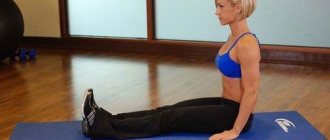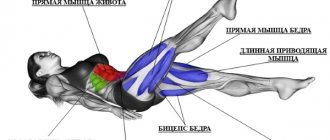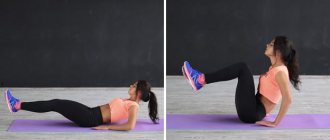Why do the rock climber exercise?
Climbing is a truly versatile movement that provides many benefits:
- Loads several muscle groups at once . Unlike abdominal folds, the “climber” not only pumps up the rectus and oblique abdominal muscles, but also puts a good load on the shoulder girdle. And pulling your knees to your chest puts stress on your thigh muscles.
- Burns a lot of calories . Since the “climbing” exercise involves many muscle groups and is performed at a fast pace, you not only pump up your abs, but also burn much more calories than during an abdominal crunch or, especially, a plank.
- No equipment required . To perform the “climber” you may only need a mat, but you can easily do without it.
- Suitable for any level of training . You can simplify the exercise by performing it on an elevated platform, and you can also make it infinitely more complex by adding other movements.
Benefits of this exercise
- Performing this exercise allows you to increase the strength and endurance of the muscles of the whole body.
- With the help of the climbing exercise, you will strengthen your abdominal and back muscles. Which will make your waist look flatter. And it will improve your posture.
- Working at a fast pace can strengthen your cardiovascular system and overall endurance.
- By strengthening the back muscles, the risk of spinal injuries will decrease.
- To perform the climber exercise, no special equipment is required. What makes it accessible to everyone and gives the opportunity to train not only in the gym, but also at home.
- When performing a mountain climber, your metabolism increases and a large number of calories are burned. Therefore, this exercise will be indispensable for overweight people.
- The climber exercise is suitable for both beginners and more professional athletes. The main thing is to choose a pace and range of movement that is comfortable for you.
- This exercise has a very large variation in execution. Therefore, you can always diversify your training program and at the same time work your muscles from different angles.
As you can see, the list of advantages is very impressive.
How to do the rock climbing exercise correctly
Stand in a lying position, place your wrists clearly under your shoulders, and direct your gaze to the floor in front of you. Stretch your body in one line from the top of your head to your feet, tighten your abs. Pull one knee to your chest, jump to change legs and continue alternating them.
You can place the foot of your working foot on the pad, leave your sock on the floor, or not touch the surface at all - choose what is more convenient for you.
Don't lift your pelvis high and try to keep it in place without rocking up and down too much. This execution will provide more stress on the abdominal muscles.
Make sure your lower back doesn't collapse when you land after switching legs. Sudden movements can lead to back pain.
Execution Variations
There are several main types of exercise. Each of which is a more complex version of a simple "climber".
This:
- Bipedal climber - allows you to shift the load on your legs and use your heart muscles more strongly.
- Climber with body rotation - maximum load on the abdominal muscles and core.
- The Bent Climber is an extreme option for those who want powerful front deltoids.
- Climber with a load - helps to strengthen all muscle groups, in addition, develops explosive speed, useful when running.
Let's consider the technique of each of them as they become more complex.
Bipedal climber
The two-legged climber is designed to take stress off the obliques. Instead, the leg muscles are additionally trained for explosive strength.
How to do it correctly? Everything is very simple (but this does not mean that the exercise is simple):
- Take a lying position - hands are above head level, parallel to each other with a wide grip).
- Maintain a slight deflection in the body (no more than 10 degrees).
- At a fast pace (jumping style), pull both legs towards the body, and then return them to their previous position at the same pace.
In fact, in this case, the athlete imitates the movement of a frog, and a high pace and full use of the leg muscles increases the heart rate compared to a simple climber by approximately 25-30%.
”alt=””>
Climber with body rotation
This is another variation of the exercise that significantly reduces the load on the leg muscles, while maximizing the use of the core and abdominal muscles, especially the oblique and lateral abdominal muscles.
How to do it correctly?
- Take a lying “grasshopper” position - your hands are located significantly below shoulder level with your palms placed narrowly.
- Align the body.
- At a fast pace, pull one leg up, touching your knee to the body.
- At the moment of pulling your leg, turn your body in the direction of the turn.
- Stay in this position for about 5-10 seconds.
- Rotate the body to the starting position with the return of the leg.
In this case, the climbing exercise is considered to be performed for the abs. Therefore, it can be used in combination with burpees, or with other sets of exercises that involve the oblique and lateral abdominal muscles.
To complicate the exercise, additional professionals, when turning the body, extend their arm upward, leaving their weight on the 1st leg and 1st arm. In this case, additional emphasis is formed in the athlete's deltas.
Climber with bent arms
This variation is almost identical to the classic exercise with the exception of one small nuance. To maximize the load on the deltoids and triceps, the arms in the starting position do not rest on the joints, but are slightly bent (as in the first phase of push-ups) and remain in this position until the end of the approach. This increases the load on the entire shoulder girdle and makes the exercise technically difficult.
How to diversify the “climbing” exercise
Moving in a semicircle
A climber in motion will increase the load on the core muscles. Move around an imaginary semicircle and come back.
Crosswise
The variation will increase the load on the obliques. Pull your knee towards the opposite shoulder.
On sliding platforms
Slide without taking your feet off the floor. You can perform this variation in socks on a smooth floor.
On hinges
Due to the instability, the exercise will become even more difficult for your abs. Adjust the loops in advance so that your body is parallel to the floor.
With hands on a medicine ball
You can do different variations with the medicine ball: put both hands on it or just one. Due to the instability of the support, the load on the muscles of the shoulder girdle and abdominal muscles will increase.
Diagonal movements
This option puts more stress on the obliques. Perform one set with both knees pointing toward one shoulder, then repeat on the other side.
On one hand
A difficult variation for those who do not have enough exercise. To do this you need to have really strong core and arm muscles. Place one hand behind your back and perform a “climber”, trying not to turn your body too much to the side.
With penetration
This option is suitable for those with strong shoulders. As you move, step back until your shoulders and arms are fully straightened, and then come back and move forward so that your shoulders go beyond the line of your wrists. To begin with, try moving forward and backward in a small amplitude and, if your hands cope, gradually increase the range.
With push-ups
A good variation for killing the shoulders and abs at the same time. The lower you go into the push-up, the more you will have to turn your knees to the sides.
Exercise options
As mentioned earlier in the article, the rock climber exercise has a large number of execution options. Depending on how you make the movement, the emphasis of the load on certain muscles changes.
Climber exercise with hands resting on a hill
To perform this option, you will need some kind of elevation. This could be: a step platform, a horizontal bench press, or a chair without a back if you train at home. This option is perfect for beginner athletes. By changing the angle of inclination upward, the press will be slightly unloaded. Because for us, it is more natural to be in an upright position. At the same time, the load on the gluteal muscles will increase. Otherwise, the principle of performing the exercise is exactly the same. Get into a plank position with straight arms. Only now we rest our palms not on the floor, but on a bench or chair. And we bend our legs one by one, pulling them to the chest.
Climber exercise standing on elbows
This option will relieve stress on your arms and shoulders. Giving you the opportunity to concentrate as much as possible on working the muscles of the abdominal cavity, pelvis, legs and back. Since we are now standing on our elbows, our body will be located much lower. And bringing a bent leg will be much more difficult. Therefore, we will have to move the hip to the side a little. And now we will lead the leg not to the chest, but to the elbow. Due to this technique, additional load will fall on the oblique abdominal muscles.
Side Twist Climber
Performing this option will shift the emphasis on the oblique abdominal muscles. It is perfect for athletes who want to reduce their waistline. Girls really like to do it. But this does not mean that this option is not suitable for men. In order to get that same twist, you need to pull your leg towards the opposite elbow. For example, the left knee to the right hand and vice versa. There is no need to further expand the body while driving. This will not affect the effectiveness of the exercise in any way.
Climber exercise with emphasis on the ball
You can use any ball, as long as it is hard. A medicine ball with special handles on which the palms are placed is also perfect. Due to this, the load on the wrists is reduced. This option is designed to develop coordination and helps to load smaller stabilizer muscles. Also, at the moment of lifting the leg, the abdominal muscles are additionally activated. Without giving us the opportunity to fall to the side.
Reverse climber
This type of climber exercise is less common than others. To perform it, we need to take a plank pose with our backs down. That is, now we rest on the floor with the heels of our feet, and not with our toes. In this pose, the load shifts to the muscles of the legs and pelvis. The abs are also tense. But his role is becoming significantly smaller. Raising your leg will be much more difficult. Therefore, the quadriceps and iliocostalis muscles will have to turn on at full capacity. The principle of implementation is this. Take a plank pose with your back down. The body should be straight, from the heels to the crown. As you exhale, bend your leg and pull it up towards the pectoral muscles. As you inhale, lower it and do the same on the second leg.
Bipedal climber
This option is the most difficult of the above. To perform it, you need to have very strong arms and shoulders. So that we can control the weight of the body at the moment the legs lift off the ground. This option is aimed at working the rectus abdominis muscle. It's worth doing it at a fast pace. The technique is slightly different from the classic version. We stand point-blank lying on straight arms. We take a breath and jump up a little. At the same time, by contracting the rectus abdominis and quadriceps muscles, we bend our legs and slightly twist our pelvis forward. As soon as we land on our toes, immediately while inhaling we do a reverse jump and return our legs to their original position.
How to Add the Climbing Exercise to Your Workout
It all depends on your goals. You can use the climber like:
- An exercise to warm up before strength or cardio training. Insert the exercise into your warm-up after joint warm-up and light cardio. Do 20–25 times.
- Abs exercise. Perform 3-5 sets of 20-25 reps, resting one minute between sets.
- Part of an intensive complex. The Climber is great for high-intensity interval training. The execution time or number of times depends on their format. For example, you can try Tabata—do a rock climb very intensely for 20 seconds, rest for the next 10 seconds, and repeat.
You can do rock climbers every workout, but it's best to alternate them with other abdominal exercises to get a good workout on all your muscles.
Techniques and recommendations
The climbing exercise is used, as a rule, by trained athletes. But if you are new to fitness, we recommend that you familiarize yourself with the features of the element. Classic technique:
- Lower yourself into a plank position with your arms straight.
- Tighten your core muscles (hips, buttocks, abs).
- Sharply pull your knee towards your stomach, but do not place your toe on the floor.
- With the same quick movement, take your leg back to the starting position and at the same time lift the opposite knee towards you.
Recommendations:
- Move without pausing. The exercise should resemble horizontal running.
- Avoid sagging in the lumbar region or, conversely, rounding your back.
- When doing this, keep your arms straight and your head down so as not to strain your neck.
- Try to move only your legs. The body and pelvis must remain motionless.
- The exercise is performed at a fast pace for a while. Beginners should start with 15 seconds per set and gradually work their way up to 1 minute.
The classic version of the “climber” is aimed at maintaining leg muscles in tone, as well as losing weight. If you want to load your abs better, perform the element at a slow pace. The technique will be like this:
- Take an emphasis lying on straight arms.
- Tighten your abdominal muscles and buttocks.
- Exhale and smoothly pull your knee towards you, while inhaling, move your leg back to the starting position.
- Do the same with the other limb.
Recommendations:
- Keep your body in one line.
- Avoid swinging your body to the sides.
- Keep your arms straight.
- The exercise should be done for 3-4 sets of 12-15 repetitions.
Contraindications to the element:
- severe cardiovascular diseases;
- pregnancy;
- recovery period after abdominal surgery;
- untreated knee injuries;
- ankle sprain.
Technique: how to do it correctly, what to look for, common mistakes
As already mentioned, in order to perform the “Climber” exercise without errors, you need to perform the plank correctly and stand in this position for at least 1-2 minutes.
If a beginner still has problems with this exercise, then first you need to adjust the technique and accustom the body to this load. Only after this can you begin to perform horizontal running.
To perform the “Climber” element, follow the instructions:
- Prop yourself on your hands and toes and fully straighten your upper limbs. Make sure your palms are opposite each other and your legs are at pelvic level.
- Stand so that your back, buttocks, and legs form one line. Tighten the muscles of your abdomen, sides, lower back, and glutes.
- Exhale, begin to bend your left leg at the knee, while simultaneously pulling it as close to your chest as possible.
- The toe can touch the floor or move it in the air.
- When your knee is as close to your chest as possible, hold for 2-3 seconds.
- As you exhale, return your left limb back. Then repeat the exercise for your right leg.
At first, hone your technique, perform the movement slowly to remember the sequence of actions. Over time, the pace of movement can be increased by quickly changing legs, pulling one or the other knee to the chest.
Important! Regardless of the pace of the Climber, the athlete must control the position of the torso and buttocks. This is a very important nuance that affects the load efficiency.
The duration of the workout is from 30 seconds to 1 minute twice or thrice with a break of no more than 1 minute. The main thing is to choose a comfortable speed that will not affect your technique. Over time, the duration of execution and the number of sets can be increased.
To perform the element correctly, you need to take into account common mistakes:
- Deflection of the lower back, lifting of the pelvis upward. When the spine bends, the static load on the abdominal muscles decreases. In addition, it is fraught with back injuries.
- Movement of the upper body. So, beginners try to reduce the load, then the target muscles do not work at full strength.
- Incorrect head position. Some athletes lower or raise their head excessively, but it should form one line with the body. Thus, the load on the cervical segment of the spine is reduced.
- Raising your arms beyond shoulder level. By moving the palms forward, the athlete increases the load on the shoulder joints.
- Rotation of the pelvis while lifting the lower limbs. You need to move your legs in the plane of your torso in order to maximally load your abs.
- Touching your knees to the floor. When lifting, you need to keep your leg in the air to work your abdominal muscles.
To support the lower back and avoid injury, the athlete must shift the load to the muscles of the abdomen and buttocks. Work at a slow pace at first, focusing on lifting your legs and positioning your body. Try to look at the floor while moving so that your neck is positioned correctly. The arms should be fully straightened; when they are slightly bent, the load on the abdominal muscles is reduced.
Be sure to check out:
Learning to restore breathing after physical activity: useful exercises Basic exercises for all muscle groups: a strong and strong body at home Jumping on a trampoline: effective for losing weight How to maintain excellent physical shape after 40 years: choosing exercises
Execution technique
Initial position:
- Take the starting position in a lying position, similar to push-ups with straight arms and toes. At the same time, make sure that the palms of both hands are parallel to each other and are in the vertical projection of the shoulders, and the legs are spread approximately the width of the pelvis.
- Stretch your body into a “string”, twist your pelvis slightly down and tighten your core muscles.
Movement:
- As you exhale, bend your right leg at the knee joint and pull it towards your chest as close as your physical fitness allows.
- The toe of the foot can be placed on the floor or the movement can continue without touching.
- Hold the final position for a second, contracting your abdominal muscles as much as possible.
- Inhaling, straighten your working leg, returning it to the starting position of resting on your toes. Make a similar movement with the other knee.
- Complete the number of repetitions specified in the training plan.
Attention!
- Do not bend your lower back or lift your pelvis upward. The spinal lordosis that forms in this position helps to reduce the static load on the press. On the contrary, traumatic tension in the back increases.
- Do not move the upper body. This makes the exercise easier to perform and reduces its effectiveness.
- Don't throw your head back. The head should be a “linear” continuation of the spine - this will avoid excessive tension in the cervical region.
- Do not move your hands beyond the projection of your shoulders so as not to create additional stress on the shoulder joint.
- Avoid rotation of the hip joint (pelvic rotation) when lifting your legs. The legs must move in the plane of the body in order to create an “optimal” (prescribed by the technique) load on the rectus abdominis muscles.
- Do not allow the knee of your working leg to touch the floor surface. Only by keeping your leg suspended can you maximally load your abdominal muscles.
Recommendations!
- Keep your gluteal muscles and abs in constant tension to stabilize your lumbar back and ensure maximum injury-free movement.
- At the initial stage, practice the exercise technique at a slow pace, with full concentration and fixing the knee to the chest. This will allow you to develop the correct dynamic stereotype.
- Direct your gaze to the floor to maintain physiological cervical lordosis and ensure a safe position of the cervical vertebrae.
- Press yourself into the floor with your arms straight. Bend at the elbow joint increases the load on the arm muscles, which weakens concentration on the work of the press.
Execution options!
- Exercise "two-legged" climber. The exercise differs from the basic version described in that it involves simultaneously bringing the knees of both legs to the chest. This variation is performed in a jump and is an order of magnitude more complex - its intensity is on average 30% higher. With this technique, the load on the leg muscles also increases.
- Exercise "running" climber. A variation in which there is an alternating change of legs at the fastest possible pace, simulating running (that is, there is no fixation of the final position of the legs). This is largely a metabolic exercise, the work of the abdominal muscles in which is secondary from the point of view of training goals.
Variations of the exercise and their technique
The classic technique of performing the “climbing” exercise cannot be called complex. To get the desired result in the form of a strong core and general tone during training, you must follow three simple rules:
- Breathing rule. Free and even breathing is your ally in the “climber” exercise.
- The rule for gradually increasing the pace of the exercise. Don’t chase speed, but develop your technique by gradually speeding up the movement with your legs.
- Rule of body position. The correct body position is tense and level, as in the starting position.
Basic exercise
Let's take a closer look at how to do the climbing exercise correctly. You can master the technique by carefully listening to the sensations, first slowly and consistently performing all the actions. You can gradually increase the pace of the workout and use more complex variations.
So, the “climber” technique:
- We take the starting position in a lying position. Arms are straightened, legs are shoulder-width apart. We rest our palms and toes on the floor. We keep the body straight, do not bend the lower back and do not push the buttocks up, and evenly distribute the body weight on the supports.
- We exhale while simultaneously tensing the abdominal muscles. At the same time, we pull the knee of one leg towards the chest (without moving the knee to the right or left). The lower back remains flat, without bending.
- We return the leg back as we exhale. The abdominal muscles remain tense. We repeat the exercise with the other leg.
- We perform the required number of repetitions in the approach. After which we rest.
The target muscles for the “climber” are the abdominal muscles. The exercise also involves the chest and buttocks.
With twisting
You can complicate the classic “climber” by slightly modifying the technique. Let's look at how to do the climbing exercise with twisting:
- To do this, we take the same starting position as for traditional push-ups (hands shoulder-width apart, legs together, keep your back straight).
- We inhale, and as we exhale, bend the right knee and, by twisting at the waist, direct it to the left side towards the shoulder. As you exhale, we return to the starting position, then repeat the exercise on the other leg.
There are 2 options for this twisting climber:
- We perform all repetitions with one leg first, then the second one;
- alternate legs, performing the same number of repetitions on each side.
The target muscles for this exercise are the internal and external obliques, as well as the rectus abdominis. On the side of the legs, this is the quadriceps femoris muscle. Accessory muscles are the pectineus and biceps femoris.
“Climber” with hands on a bench or on a ball
To perform a complicated “climber” you will need additional equipment: a bench, a ball (a medicine ball, a gymnastic ball or a Bosu hemisphere). Technique:
- We take the position while lying down, placing our arms on a support (ball, bench) so that they are directly under the shoulders and are fully straightened.
- We tense the muscles of the torso, especially the abs.
- Raise your knee to your chest (as you exhale), while trying to keep your torso as straight as possible.
- While inhaling, we return to the lying position and repeat the exercise with the other leg.
The exercise will be most effective if you keep your body straight while doing it using tense abdominal muscles. When raising your knees, you need to pay attention to your lower back. It should not be rounded or bent. While climbing, you should not bend your elbows.
"Climber" bipedal
Exercises for rock climbers at home can be complicated. After mastering the traditional technique of the exercise, you can move on to the advanced version of the two-legged climber. The main difference is that two legs are involved in the main movement. How does this training work?
- We take the starting position (lying position). Hands shoulder-width apart, feet together.
- We check the position of the body. It should be like a straight line. We do not round the lower back.
- As you exhale, pull the knees of both legs to your chest in a buckle. As we exhale, we come back.
In addition to the abs, the target muscles in this version of the climber are also the arms and back. Auxiliary muscles are the core and delta muscles.
Developing angles and grip strength
To climb a sheer rock, you will need a strong and resilient angle - the ability to hold your weight on bent arms for a long time.
Dynamic angle - pull yourself up halfway, elbows bent, angle 90 degrees, then continue to hold the position, while grabbing the bar with different grips, rotating around your axis.
In this way we can develop:
- Tenacity
- Endurance
- Vestibular apparatus
Breaking angle
We hold the angle of 90 degrees in a reverse grip, begin to pull ourselves up, and change the grip in flight, without straightening the elbows.
Fixing the corner in the upper position
We pull ourselves up completely and hold our body in this position until failure, using an overhand grip. When there is no strength left to hold on, we lower ourselves for a few seconds, but then spin again - this is necessary for maximum developed endurance.
A rock climber must do the exercise - but do not forget about the process itself, because rock climbing trains all the necessary parts of the body. If you do not have the opportunity to train in the mountains, then do the exercises that you have read, they will serve as excellent preparation before conquering future peaks.
How to do the climber exercise correctly?
Positive results from exercise can be achieved by correctly performing the “climber” abdominal exercise. The easiest way is to use the classic technique, which even a beginner can handle without outside help or explanation. But you need to follow a number of important rules:
- Watch your breathing. Breathing should be uniform and free.
- Increase the load gradually. You cannot sharply increase the load on an unprepared body, this can lead to injury. Pay more attention to the rules of execution rather than the number of repetitions.
- Control your body position when training. While performing the exercise, it is necessary to maintain the body in a tense position without arching the back.
Taking these recommendations into account, you can proceed directly to performing the classic “climber”.
Lie on the floor, straighten your arms and place your feet shoulder-width apart. Place your toes and palms on the floor. Keep your back straight and do not stick your buttocks forward. Your weight should be evenly distributed throughout your body.
Take a deep breath, tighten your abdominal muscles and pull your right knee towards your chest. It should not deviate to the side. You need to be especially careful to maintain your body in a straight position: if your back arches, your abdominal muscles will not be activated as needed.
Then the knee slowly returns to its original position and exhales, but without relaxing the abs. The same is done with the left foot. The steps are performed in sequence and evenly. The number of repetitions is determined individually, depending on the athlete’s preparedness.
At first, it is highly recommended not to overload your body; you should also not complicate the technique until you have mastered it completely.
Alternative techniques for performing the rock climber exercise
To get strong and beautiful abs as quickly as possible, and also to diversify your workouts, you can use other “climber” techniques. The following exercises are very popular:
- With twisting. It differs from the classic version in that when the knee of one leg is bent, it is directed to the side - towards the shoulder, and then returns to its original position after exhaling. This embodiment allows you to focus on the oblique and internal abdominal muscles.
- Hands on a bench (you can use a medicine ball or exercise ball instead of a bench). When performing, you need to rest your hands on the bench (arms should be straight and palms directly under your shoulders). After taking the position, take a deep breath and pull your knee to your chest. During the execution, monitor the position of your torso; it should be straight at all times.
- Bipedal. A more complex version of the “climber”, which you can move on to after mastering the classic and other described techniques. The exercise involves using both legs at the same time. After taking the starting position, you need to bring your legs together and place your hands shoulder-width apart. After exhaling, pull both legs towards your chest as you jump, and then return them to the starting position. This version of the technique allows you to pump the muscles of the legs, arms, deltas, back and core simultaneously with the press.
When performing any technique, remember the quality of execution. Many people strive to get results faster, so they neglect the prescribed rules, but this is absolutely forbidden, since violations are fraught with a variety of injuries.
Follow the provided techniques and rules, and you can get a beautiful and resilient body.
The video will allow you to see with your own eyes how to perform the exercise in order to avoid mistakes and avoid injuries.
What muscles work?
The climbing exercise works many muscle groups. Its main advantage is its versatility, as it is suitable for both men and women. It will be an ideal start for obese people, because it combines multi-joint and aerobic characteristics. For the complete anatomy of the exercise, see the table below.
As you can see from the table, this exercise uses almost all the muscles on the human body. By using special rubber bands, you can significantly increase the emphasis on the abdominal muscles or leg muscles. Unfortunately, due to the inability to evenly distribute the increased load across the entire body, the climber ended up on the list of aerobic exercises.











